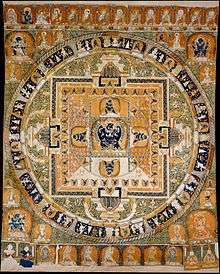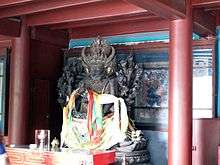Yamantaka




Yamāntaka (Sanskrit: यमान्तक Yamāntaka or Vajrabhairava Tibetan: གཤིན་རྗེ་གཤེད་, རྡོ་རྗེ་འཇིགས་བྱེད།, Wylie: gshin rje gshed; rdo rje 'jigs byed ; Japanese: 大威徳明王 Daitokumyōō; Chinese: 大威德金剛; pinyin: Dà Wēidé Jīngāng; Mongolian: Эрлэгийн Жаргагчи Erlig-jin Jarghagchi) is the "lord of death" deity of Vajrayana Buddhism.[1] Sometimes he is conceptualized as "conqueror of death".[2] He belongs of the Anuttarayoga Tantra class popular deity within the Gelug school of Tibetan Buddhism.
Outline
Yamāntaka is a wrathful expression of Mañjuśrī, the Samyaksambuddha of wisdom who, in other contexts, also functions as a dharmapala or a Heruka. Yamāntaka manifests in several different forms, one of which (via yogatantra) has six legs, six faces and six arms holding various weapons while sitting or standing on a water buffalo.
Within Buddhism, "terminating death" is a quality of all buddhas as they have stopped the cycle of rebirth, samsara. Yamantaka, then, represents the goal of the Mahayana practitioner's journey to enlightenment, or the journey itself: in awakening, one adopts the practice of Yamāntaka – the practice of terminating death.
Yamantaka in Japanese Buddhism
In Japanese esoteric teachings, Dai Itoku-Myoo is the wrathful emanation of Amida and is pictured with six faces, legs and arms holding various weapons while sitting on a white ox.[3]
Etymology
Yamāntaka is a Sanskrit name that can be broken down into two primary elements: Yama, the name of the god of death; and antaka (making an end).[4] Thus, Yamāntaka means “Destroyer of Death” or "Conqueror of Death".[2][5]
References
- ↑ John Whalen-Bridge; Gary Storhoff (2009). Emergence of Buddhist American Literature, The. State University of New York Press. p. 170. ISBN 978-1-4384-2659-4.
- 1 2 Buswell, Robert Jr; Lopez, Donald S. Jr., eds. (2013). Princeton Dictionary of Buddhism (Yamantaka). Princeton, NJ: Princeton University Press. p. 1020. ISBN 9780691157863.
- ↑ Coulter, Charles Russell; Turner, Patricia (2013). Encyclopedia of Ancient Deities. Routledge. p. 140. ISBN 9781135963903.
- ↑ Monier-Williams (1899). A Sanskrit-English dictionary: Etymologically and philologically arranged with special reference to Cognate indo-european languages. Oxford: The Clarendon Press
- ↑ Getty, Alice (1914). The gods of northern Buddhism], their history, iconography, and progressive evolution through the northern Buddhist countries. Oxford: The Clarendon press. pp. 145–146.
Bibliography
- Gonsalez, David (2011). The Roar of Thunder: Yamantaka Practice and Commentary. Snow Lion Publications. ISBN 978-1-55939-387-4.
- Ra Yeshé Sengé (2015). The All-Pervading Melodious Drumbeat: The Life of Ra Lotsawa. Translated with introduction and notes by Bryan J. Cuevas. Penguin Classics.
External links
- Daïitoku
- Vajrabhairava (Yamantaka) practice support
- Wrathful Guardians of Buddhism - Aesthetics and Mythology
- Yamantaka org
| Wikimedia Commons has media related to Yamantaka. |